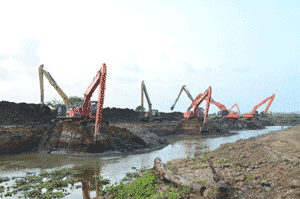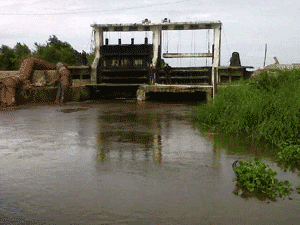ANY country aspiring to be a major agriculture centre, both in terms of supplying food, bio energy and also exports, must have a sophisticated drainage and irrigation (D & I) system. The elements of a good D & I system are in place in Guyana, but it will not achieve such classification unless properly maintained and complemented.
 No country is able to develop a meaningful agriculture sector unless it has adequate drainage and irrigation, as this has proven to be an essential ingredient in ensuring that development take place, and this is one of the main reasons why the PPP/C Government took the decision to rectify the drainage network which was abandoned by the previous Government in the 1980s. Through this network, over the past 20 years, the integrity of canals, sluices and pump stations was restored.
No country is able to develop a meaningful agriculture sector unless it has adequate drainage and irrigation, as this has proven to be an essential ingredient in ensuring that development take place, and this is one of the main reasons why the PPP/C Government took the decision to rectify the drainage network which was abandoned by the previous Government in the 1980s. Through this network, over the past 20 years, the integrity of canals, sluices and pump stations was restored.
At present, 42 pumps are operated at pertinent locations, compared to the nonfunctional ones this government inherited. This has cost billions of dollars, but that investment had to be made and there is now more land under cultivation. Rice has moved from just over 40,000 acres in 1990 to now more than 170,000 acres on an annual basis, because of two crops per year.
The past
Giving an assessment of D & I over the years, Agriculture Minister, Dr Leslie Ramsammy said there was a decade of lost opportunity, the 1980s, when canals and sluices were not maintained and as a consequence, they were lost. Virtually all of the pumping stations, except GuySuco’s, were lost.
The very expensive initiative now has been to replace them and the PPP/C administration has been doing so; but it is now realized that even if the administration fully restores what was there in the 80s, the country will still be in trouble because circumstances have changed.
Agriculture is expanding so there is more land under cultivation. There are now more housing schemes so there is an expansion of the zones of occupation, not only for housing and agriculture, but also for other industrial purposes. But at the same time this is being done, global warming and climate change has created weather patterns that, even if there was no expansion, the existing drainage and irrigation structure would not have been enough, Dr Ramsammy said.
But at the same time this is being done, global warming and climate change has created weather patterns that, even if there was no expansion, the existing drainage and irrigation structure would not have been enough, Dr Ramsammy said.
Correcting the situation
The transformation which has occurred over the last 20 years is evident in the many D&I infrastructure countrywide. These include works in the Black Bush Polder Scheme, a major agriculture area, and additional D&I structures in Regions 3, 4 and 6, that cost $875M.
The $3.6B Hope Canal is expected to resolve the woes of Regions 4 and 5 residents, and thus far the project is 75 % complete, with over $2B having been spent.
The $324.9M sluice at De Willem is proving to be a good investment, as well as the $200M pump station at Greenfield, East Coast. Pump stations have been rehabilitated in Stanleytown, Region 3 and Liliendaal and Kitty, Region 4.
Additionally, under the Agriculture Support Services programme, pumps stations have been rehabilitated at Victoria and Cane Grove, and new pumps installed at Lusignan and at Number 19 and 42 Villages in Region 6, while pumps were rehabilitated at Trafalgar, Region 5, and Anna Regina and Cozier in Region 2.
Moreover, as Guyana continues to increase its pumping capacity on the coast, other pump stations and sluices will soon be built in the Canals Polder, in Region 4 and Black Bush Polder, Region 6. The National Drainage and Irrigation Authority (NDIA) is now fully equipped with a fleet of 57 excavators to carry out works at the various projects.
The National Drainage and Irrigation Authority (NDIA) is now fully equipped with a fleet of 57 excavators to carry out works at the various projects.
Over the past five years, over $10B has been spent on D&I to restore the efficiency of structures to ensure that drainage is effective; and apart from interventions, commitments are also being fulfilled through investments; among them are 14 new pumps, six of which are mobile, and eight excavators.
On the Cunha Canal, unfortunately, much money is being spent on its redoing, and this would help to explain the destruction in terms of drainage and irrigation during the 70s and 80s, Minister Ramsammy said.
The East Demerara Water Conservancy had five relief structures. Maduni/Lama on the Eastern side opened up to Mahaica/Mahaicony/Abary; on another side there were the Kofi/Land of Canaan sluice, the five- doors and the Cunha, the latter being the larger of the three on the western side.
In 1990, the then Government closed the Cunha Canal to accommodate an investment by Barama; and because of that closure, the dependency on the Maduni became greater with global warming, more rain and climate change. It meant that virtually every time the rainy season arrived, those structures had to be opened.
The East Demerara Water Conservancy is being managed on a daily basis with reports a
nd discussions three times daily, whether it rains or not. That is an important fact to note, since with the dry season, it must be ensured that water is available. In January, it is about releasing water, in August, it is about keeping water.
Cunha therefore is significant, because once the canal is there, there is less need to release water at the Maduni and Lama and expose all Region 5 residents, not only to flooding of the residential communities, but their agricultural  livelihood.
livelihood.
The future
It is this past and the future that determines why structures are needed, such as the Hope Northern Relief Channel. But it is not only the Hope Canal, at Number 43 Village, Corentyne; a contract was signed in August, for upgrading of the Channel at Number 43 Village.
This channel would supply the front lands of that Central Corentyne area and also the Black Bush Polder area.
A contract has been restructured which was issued to the Horizon Company over a year ago, for the construction of the Northern Relief Channel at the Eversham area. The contract will now accommodate the addition of a new channel for Genevieve, Black Bush Polder.
This was added since during the rainy season, there is some flooding in the Yakusari Genevieve area. This happens because large areas are dependent on the Yakusari Number 43 channel, so another channel similar to Hope is being built there.
Then came the Cunha Canal. But even before this, there were the flooding episodes in the Canals Polder. Indeed, relief channels currently in place are not enough. These are the A-Line canal and the Canal Number 1 main canal, the Canal Number 2 main canal, and the B Line and Centre Line canals.
The Regional desire was for an additional channel, but that was never built in the 50s. But the PPP/C Administration will do so, according to the Agriculture Minister.
The consultation has been done and preparation is under way for the design of another channel alongside of Canal Number 2, going towards Wales. This channel will connect to the Demerara River and increase the drainage flow.
Additionally, government is reconstructing a canal by the Bonasika Creek, running parallel to it. This is a phased canal that will also help with drainage and irrigation in that area.
Government has been building, too, going from Mora Point, Biaboo, another canal similar to Hope that comes out of Cottage, Mahaicony.



.jpg)








